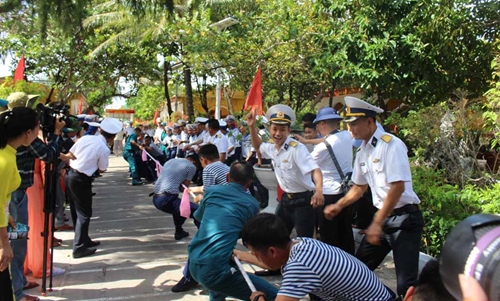This has become one of the cultural traditions and an indispensable part in their spiritual life.
Truong Sa (Spratly) Pagoda is located in the center of Truong Sa townlet, Truong Sa island district. It is opposite the monument dedicated to heroes and martyrs and Uncle Ho memorial house. The three projects create a special architectural complex imbued with beautiful cultural traditions of the Vietnamese people.
    |
 |
|
Joys on Truong Sa Island during a Tet holiday |
Head of Truong Sa Pagoda Venerable Thich Nhuan Dat once oversaw a pagoda on Phan Vinh Island in Truong Sa district for two years. With the voluntary spirit and desire to join hands with the island’s troops and local people to build a peaceful life, since late 2016, Venerable Thich Nhuan Dat has held the position as head of Truong Sa Pagoda.
Visiting Truong Sa island district, I met Venerable Thich Nhuan Dat. He revealed that along with worshiping Buddhist deities, pagodas in the district also have altars to worship heroes and martyrs who sacrificed themselves to protect national sovereignty over sea and islands. Troops and islanders come to pagodas for many reasons, but in a word, all of them show their whole hearts towards the beloved Fatherland, wishing that the best things would come to everyone in the upcoming new year and the country would be more peaceful and prosperous, to name but a few.
For many generations, wherever Vietnamese people live, there is a spiritual culture. It means that pagodas and temples are places for the Vietnamese people to express their beliefs and aspirations for peace. For troops and islanders in Truong Sa district, they go to pagodas on the first days of the new year not only to pray for good luck, find peace for their souls and leave all hardships behind but also to show their sentiments towards their origin. According to Truong Sa’s customs, people often offer fruits, a pair of Chung cakes (Vietnamese square sticky rice cake), or a pack of biscuits, and other things to deities. The offerings are simple, but they contain many wishes of troops and islanders. They all pray for good weather, peaceful life, and prosperity.
Mr. Le Dinh Hai, Chairman of the Truong Sa district People’s Committee shared that Buddhism is one of the major religions in Vietnam. Coming to pagodas during Tet holiday offers people an opportunity to clear their bodies and mind, bathing in the peace and calmness of the meditation places. Moreover, pagodas in Truong Sa district are also a spiritual fulcrum of islanders and a landmark of sacred sovereignty, demonstrating their inner wishes for peace.
I still remembered my visit to Truong Sa district on the days leading up to Tet holiday three years ago. It warmed my heart to hear a sacred pagoda bell echoing through a peaceful island. Currently, apart from Truong Sa Pagoda, Truong Sa district also has many pagodas on other islands of Son Ca (Sand Cay), Sinh Ton (Sin Cowe), Song Tu Tay (Southwest Cay), Phan Vinh (Pearson Reef) and Nam Yet (Namyit Island). All pagodas in Truong Sa island district have main worshipping halls facing Hanoi capital, like the the heart of every Vietnamese towards the heart of the Fatherland, expressing the Vietnamese people’s desire for a peaceful life and friendly relations.
Mr. Thai Nhat Truong who has lived on Spratly Island for many years shared that every year on the first day of the first lunar month, he takes his family to the pagoda early in the morning. On the remote island, pagodas are not a place to express their religious beliefs but also to find peace in mind, especially when they hear pagoda bells ringing in the same way as on the mainland.
Like Truong’s family, members of Mrs. Lu Thi Kim Cuc’s family on Sin Cowe Island often visit the pagoda at the beginning of the lunar New Year to pray for health, luck, and happiness for themselves and their loved ones, as well as for troops and other islanders. “The happiest moment is on the days before the Tet holiday. In the early morning of December 28 of the lunar calendar, islanders and troops jointly make Chung cakes. At night, adults and children gather around the fire and sing until late. On the last day of the old lunar year, families prepare a feast (also called lunar New Year’s Eve meal) to invite ancestors and deceased family members to celebrate Tet and reunite with their children and grandchildren. However, the flag-raising ceremony on islands is the most sacred event,” Mrs. Cuc said.
For troops and islanders, after burning incense at the pagoda, they organize a flag-raising ceremony on the New Year's Day, together listen to New Year greetings of the State President and the Party Committee of the Naval Command. At the end of the ceremony, the naval and militia forces stage a parade around the center crossing the sovereignty landmark.
Meanwhile, various activities take place, including artistic and sports contests, a Chung cake making competition, among others. These activities have become a cultural beauty of the military and civilians on the front-line of the Fatherland.
Indeed, spring in Truong Sa is the season of flowers, heaven and earth scenes mixed with the love of people, the love of sea and islands, and the love of the Fatherland. On remote islands, the happiness, silent dedication, and sacrifice of sea-keeping soldiers mingled with the immense waves.
A new spring is drawing near the Spratly archipelago. In the mid of vast sea and skies, the hearts of soldiers on islands overflow with pride and emotion. They feel proud of their missions of protecting national airspace and sea. These days, their hearts are towards the homeland, towards heroic martyrs who laid down their lives to safeguard the national sovereignty over sea and islands.
Translated by Quynh Oanh